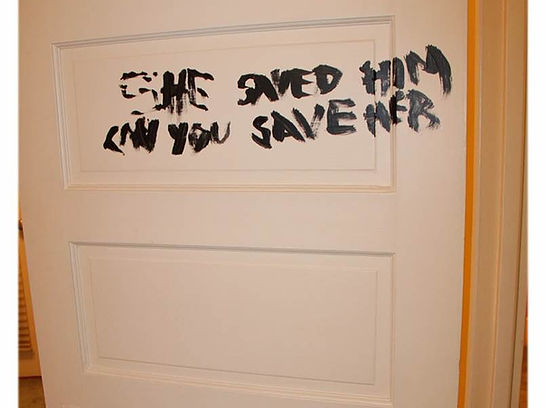The practice of bondage is the key to solving the Rebecca Zahau case, according to Caitlin Rother, The New York Times bestselling author and veteran investigative journalist who wrote Death on Ocean Boulevard, a book nine years in the making.

The San Diego Sheriff’s department deemed it a suicide when, on July 13, 2011, Rebecca was found at the historic Spreckels Mansion, naked, gagged, with her ankles tied and her wrists bound behind her back, reportedly dead from hanging herself from the second-floor balcony. The sensationalism of her death spurred a world-wide media frenzy and a lawsuit from the Zahau family, who claim Rebecca was murdered.
Rother says she’s not convinced the death was a suicide and she’s not sure it was murder, either. But one thing is certain: the scene was staged. Was it a suicide staged to look like a homicide, or a homicide staged to look like a suicide? The question remains, but Rother is convinced that certain clues cannot be overlooked.
“I think that this bondage thing is the key to the case,” said Rother in a phone interview. “If she did commit suicide, why did she tie herself up and kill herself like that? It has to have some kind of meaning. And if someone murdered her, same thing.”
Rebecca, the girlfriend of pharmaceutical tycoon Jonah Shacknai, was only 32 when she was reportedly found dead at the historic home on Ocean Boulevard, cut down from a rope by Jonah’s brother, Adam Shacknai. The death happened only two days after Jonah’s six-year-old son, Max, suffered a devastating fall when Rebecca was taking care of him. Max died from his injuries five days later.
Although authorities called it a suicide resulting from her guilt, her family, along with numerous others were quick to question the decision: why would Rebecca tie herself up naked, and how could she manage to hang herself from the second story balcony with both hands bound behind her back? It seemed too implausible, too strange, and the ruling ignited an explosion of alternative theories…murder among them. (Adam Shacknai was found responsible for her death in 2018 in a civil lawsuit brought forth by the Zahau family; his insurance settled the case for $600,000, although Adam denies playing any role in her death.)

In her book, Death on Ocean Boulevard, released in May of this year and currently available at Bay Books, Rother, a Pulitzer Prize nominee and veteran investigative reporter of 19 years, shines a light on thought-provoking new details, including information from eight separate, two-hour-long interviews with Jonah Shacknai. She says her interviews with Jonah gave her important perspective into his relationship with Rebecca. I asked Rother if their discussions, along with all of her research and investigations, made her view Rebecca in a different way.

“Absolutely,” said Rother. “Rebecca told different people different things, and they completely conflicted with each other. She had a troubled history.”
Rebecca was the victim of childhood sexual molestation, which is confirmed by her sisters. The pattern of abuse allegedly continued with her husband of eight years, Neil Nalepa, as she shared with friends and family he was both verbally and physically abusive. In addition, she claimed Nalepa kidnapped her and held her against her will after they split and she started dating a new boyfriend.
In 2009, Rebecca was picked up by Arizona police for shoplifting $1,500 worth of jewelry at a Macy’s. (According to a legal website, shoplifters are caught only once out of every 48 times they shoplift.)
“So, you have all these different pictures of Rebecca, and all these different stories,” said Rother. “Her family sees her one way … but I’m not sure they are accepting of who she really is.”
Another clue that cannot be overlooked: the cryptic message, painted on the door to the guest bedroom, where Rebecca’s hanging rope was anchored to an antique-replica bed. SHE SAVED HIM, CAN YOU SAVE HER is written in uppercase letters.

Adam’s longtime girlfriend, Mary, told Rother in a phone interview that she had her own theories on why Rebecca would kill herself in this way and leave that note. She said Rebecca wanted Jonah to think that somebody had tried to kill Max and failed, and came back and killed her.
“She wanted him to think she died a hero,” Mary told Rother in the book. Rother says Mary’s interpretation was interesting, and the message was a very important clue.
“Just like the bondage,” she says. “If you can figure out the bondage, and where that came from, and how it plays into this case, it has to come from somewhere. It’s not a random thing. And it plays into the taunting and angry tone of the message on the door.”
She says a detective working on the case had a theory that Rebecca was angry at Jonah, and this note could have been an angry message to him, and a sign that they weren’t doing well. Rother said that, indeed, according to her conversations with Jonah, their relationship was on the rocks, and they were probably going to break up at the end of the summer.
Rother says the book took her nine years to research and write, and at this point she probably knows just as much about the case as the San Diego Sheriff’s Department. But ten years later, questions still linger.
Rother asks: If it was a suicide, why wasn’t Rebecca decapitated, or have a broken neck, because it was a nine-feet, two-inch fall? How did she fling herself over the railing when there is just one confirmed toe print next to the railing? How did she know how to cut the rope to the right length, so she didn’t hit the ground? How did she learn to tie these elaborate knots?
If it was a murder, why was there no DNA or fingerprints tying Adam Shacknai to the scene? What’s the meaning of the note on the door? Why didn’t investigators collect Adam’s phone? They collected everyone else’s, and he was the only person at the scene. Why was there no DNA on the items where it should have been there?
Rother says many of the questions are in regards to basic forensic evidence, which begs the question: was there a problem with the methodology by which the forensic evidence was collected?
The 350 page book, although laden with details, reports, and information, is anything but clunky. It guides the reader through the chilling death, the lawsuit and lingering questions in swift fluidity, and most importantly, it unveils insightful new details, most as vexing and troubling as they are illuminating. A renowned psychic’s report, Rebecca’s laptop’s browser history, a book found at the mansion and a DVD entered into evidence are equal parts telling and disturbing.
Rother says she hasn’t given up on the case, and continues to receive emails and review details regarding Rebecca’s Zahau’s death.
“Somebody involved in this case has some bondage knowledge and experience,” said Rother. “And I think there are people who have secrets, and there are people who have reputations and narratives to protect. And I don’t know who that is.”

Rother has written or co-authored fourteen books. Her work has been published in Cosmopolitan, The Los Angeles Times, The San Diego Union-Tribune, The Chicago Tribune, The Washington Post, The Boston Globe and The Daily Beast. As a TV crime commentator, her more than 200 media appearances include 20/20, People Magazine Investigates, Crime Watch Daily, Australia’s World News, Nancy Grace, Snapped, and numerous shows on Netflix, Investigation Discovery, HLN, Reelz, Oxygen, E!, A&E, C-SPAN, and numerous PBS affiliates. Readers can learn more at CaitlinRother.com.




